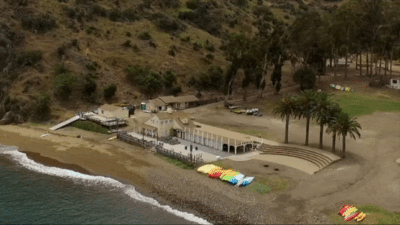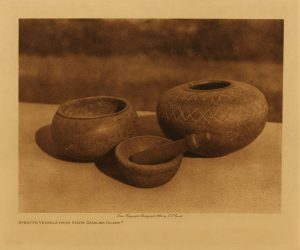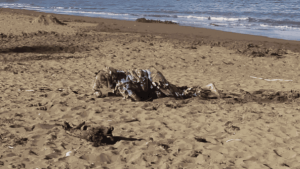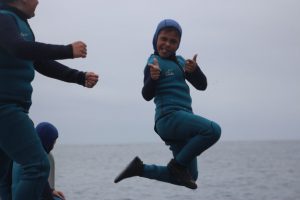
Toyon Bay is beautiful from land, sea, or air.
The Catalina Island Marine Institute has been an amazing marine science hub for thousands of students and campers from around the world since 1979. CIMI at Toyon Bay is just one of three camps on Catalina Island, but has an incredibly rich history. Unfortunately, this is rarely explained to visitors in depth, as our history normally takes a backseat to exploring our beloved ocean and beautiful labs. Today, that is not the case! We are going to go in depth about how Toyon Bay changed throughout the years, and became the home we all know and love.
You can easily see the geological processes that led to the formation of the Channel Islands, illustrated scientifically here in Oreo crème.
Our story starts out millions of years ago, when the island was first formed through a process called subduction. The large Pacific Plate, an oceanic plate, pushed the Farallon Plate underneath the continental North American Plate causing the subduction of the Farallon into the earth’s mantle. Out from behind the moving Pacific Plate popped Catalina Island and the rest of the southern Channel Islands. Furthermore, over millions of years, water and wind rushing through our island caused erosion in our canyon thus birthing the beautiful inlet we now know as Toyon Bay.
 Bowls carved from steatite, or soapstone, by the island’s first inhabitants, the Tongva.
Bowls carved from steatite, or soapstone, by the island’s first inhabitants, the Tongva.
Fast forwarding millions of years we arrive at Toyon Bay’s first inhabitants, the Pimuvits; also known as the Tongvans or, to the Spanish, the Gabrielinos. Believe it or not, these Native Americans settled in our bay and thrived on the abundance of ocean resources that we now admire on our snorkels. Historians believe that the Pimuvits had been living on Catalina Island for at least 8,000 years before they finally moved back to the mainland. Their name comes from the original name they had for the island: “Pimu!”
 You can see the dorm Flying Fish in this historical photo of the lower quad!
You can see the dorm Flying Fish in this historical photo of the lower quad!
The next resident of our bay was a prestigious boarding school called the Catalina Island School for Boys. These gentlemen were the ones responsible for all of the antique buildings where you sleep and eat while you’re here. This school officially opened on September 21st, 1928 with an enrollment of 14 boys. Soon the popularity of the school skyrocketed and was sending many students to Harvard, Yale, Princeton, and other ivy-league schools. The dorms even had some of the same names as they do today such as Bald Eagle, Barracuda, Torqua, Flying Fish, and Albatross (above)! Even cooler, the shrine at the top of our shrine loop trail was called the “faculty shack” and was a hang out spot for all of the teachers (below). It was built by students that were in detention by lugging hundreds of pounds of lumber, stones, and cement up the hillside… talk about a punishment! Unfortunately, the glory days of the Catalina Island School for Boys ended with the beginning of WWII and the bombing of Pearl Harbor. This gave birth to the Bay’s next chapter, a United States OSS spy training camp!

The “Faculty Shack” or our famous Shrine of the Shrine Loop Trail
Upon the start of WWII, the entirety of Southern California feared Japanese invasion. Catalina Island was especially thought to be a spearhead for a Japanese attack on American soil. Naturally, the island became heavily fortified and turned into a spy training ground for the Office of Strategic Services, now the CIA. Toyon Bay itself shifted gears to churning out guerilla soldiers that would be sent to Japan to fight in the pacific theatre of WWII. The area around our gaga ball pits was once a shooting range, and small bullet cases have been unearthed by recent storms! Spy recruits that were stationed in Toyon Bay were nicknamed the “Bang Bang Boys” as they were given extreme training routines. One required them to survive in the interior of the island for five whole days with nothing but a knife and some metal wire. Another had them infiltrate the city of Avalon on SCUBA and capture the post office. The guards in Avalon had no idea this exercise was taking place, so the recruits were risking a lot!
 Toyon provided ample facilities for spy training, complete with piles of seaweed that camouflaged recruits perfectly.
Toyon provided ample facilities for spy training, complete with piles of seaweed that camouflaged recruits perfectly.
After WWII, the camp bounced around owners and became a resort, dude ranch, singing camp, and again a boarding school. Then in 1979, Ross and Kristy Turner decided to purchase the facility and start the Catalina Island Marine Institute! It’s crazy to think that from the formation of the island around 20 million years ago to today in 2017 we would have such an amazing place like CIMI call Toyon Bay one of its homes. Who would have thought that your trip to Toyon Bay has been 20 millions years in the making!
You know it… see you soon!




